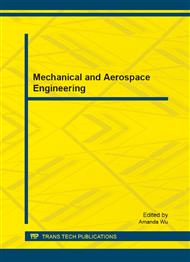[1]
H. Luo, M. G. Blyth and C. Pozrikidis: J. Eng. Math, Vol. 60 (2008), p.127.
Google Scholar
[2]
F. Kang and K. Chen: Int. J. Multiphase Flow, Vol. 21 (1995), p.501.
Google Scholar
[3]
W.P. Graebel: Advanced Fluid Mechanics(Elsevier Inc., USA 2007).
Google Scholar
[4]
R. L. Fosdick, K. R. Rajagopal in: Proceedingsofthe Royal Society of London Series A, MathematicalandPhysicalSciences, Vol. 369 (1980).
Google Scholar
[5]
T. Hayat, F. Shahzad, M. Ayub: Applied Mathematical Modeling Vol. 31 (2007), p.2424.
Google Scholar
[6]
F. Ahmad: Common Nonlinear Sci. Numer Simulat Vol. 14 (2009), p.2848.
Google Scholar
[7]
A. Shah and S. ul Islam: World Applied Science Journal Vol. 9 (2011), p.1397.
Google Scholar
[8]
S. Liao: The proposed homotopy analysis technique for the solution of nonlinear problems (PhD thesis, Jiao Tong University, Shanghai 1992).
Google Scholar
[9]
S. Liao: Beyond Perturbation: introduction to homotopy analysis method (Chapman&Hall/CRC, 2004).
Google Scholar
[10]
A. M. Siddiqui, M. Ahmed, S. Islam andQ. K. Ghori: Acta Mechannica Vol. 180 ( 2005), p.117.
Google Scholar
[11]
T. Hayat, R. Ellahi, F. M. Mahomed: Acta Mechanica Vol. 188 (2007), p.69.
Google Scholar
[12]
L. Talon, E. Meilberg: J. Fluid Mech. Vol. 686 (2011), p.484.
Google Scholar
[13]
A. Pinarbasi and A. Liakopoules: J. Non-Newtonian Fluid Mech. Vol. 57 (1995), p.227.
Google Scholar
[14]
R. S. Rivlin and J. L. Erikson: J. ration. Mech. Analysis Vol. 4 (1955), p.323.
Google Scholar
[15]
A. A Jouneidi, G. Domairyand, M. Babaelahi: Meccanica Vol. 45 (2010), p.857.
Google Scholar
[16]
A. Alomari, M. Nooraniand R. Nazar: Appl. Math. Scie. Vol. 2 (2008), p. (1963).
Google Scholar
[17]
S. Abbasbandy: Z. angew. Math. Phys Vol. 59 (2008), p.51.
Google Scholar
[18]
M. Sajid, T. Hayat andS. Asghar: Nonlinear Dynamics Vol. 50 (2007), p.27.
Google Scholar
[19]
J. Cheng, S. Liao, R. N. Mohapatraand K. Vajravelu: J. Mathematical Analysis andApplication Vol. 343 (2008), p.233.
Google Scholar
[20]
M. Mohinddin, M. Sadiq, A. Siddiqui: The Journal of Num. And Comp. Scien. Vol. 1 (2010), p.106.
Google Scholar


